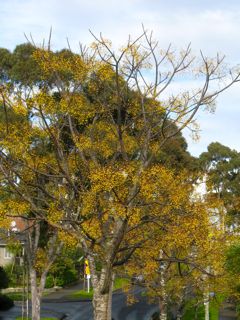This winter I'm noticing things I've never seen before. As I drive down a certain Auckland street, I see that the melia trees are in full berry. They are like lots of little suns, all over the trees, and they seem to light up the whole street on gloomy winter days.
I didn't even know this tree until I started watching one in my driveway, as it grew into leafing in the spring and then became bare at the end of autumn. The appearance of the tiny golden berries was a surprise.
It's a native of India, South East Asia and Australia, and has many other names, including white cedar, chinaberry, umbrella tree, and Pride of India.Like the titoki berries, these little suns contain a secret. Inside each is a 5-grooved seed. The seeds have traditionally been used for rosary beads.
Of course, as soon as I read this, I wanted to see one. I was able to find three berries on the ground under the melia tree in my driveway, and uncovered the hard little seed in two of them, which I've photographed next to the berry itself. As you can see, the surfaces are perfect for the fingers to grip as the rosary is worked.
What treasures there are in nature, always awaiting discovery. This winter is yielding many secrets.





7 comments:
It is so exciting watching and reading your discoveries this winter, Juliet. I just love the idea of the berries reflecting the sun and being little suns themselves and your description of the seeds and their grooves has my hands almost feeling them across the thousands of miles. I have heard of the chinaberry. Our climate is probably too cold for them, but, I am wondering if they are in are southern states.
Yes, I read that they are found in the southern united states, Penny. Our winter treasures have to be searched for, but your summer treasures are on full display. Thank you for your visits and interest; much appreciated.
I am really enjoying following your observations regarding Melia. We have the one in our front garden that still has leaves on it but also the green seeds are appearing now. And I can visit the one down by the local dairy which is covered in green seeds.
Your latest post sent me off to find my Palmers Manual of Trees and Shrubs and this is part of what it says about Melia Azedarach ( common names Indian Lilac, Bead Tree and Chinaberry).
" Lilac, 2cm, chocolate or caramel scented flowers in loose terminal panicles produced freely on current season's growth along with the leaves in spring, followed in autumn by clusters of smooth shiny round-ovate 12mm fruit, at first green, ripening to bright yellow. Fruit clusters hang on the tree for months, long after leaf fall, ornamental through winter months and relished by birds which visit daily and gorge themselves for hours. Fruit, which is toxic to humans, contains a five-sided yellowish brown stone used in Italy for rosaries. Azedarach - a contraction of the Persian vernacular "azaddhirakt" or noble tree. Deciduous. 7x5m"
I have always known my one as a Bead Tree but I did not know why it was so named. I am both enchanted and delighted to learn that the inner seeds have a spiritual application.
The lilac coloured flowers are beautiful but sadly are up so high that I have not smelt the chocolate or caramel perfume!
What a fascinating tree we are watching.
I forgot to say that I will watch for birds gorging on the ripened seeds. This isn't something I have been aware of before.
More treasures to search out.
Lynley, thanks so much for this extra information. It certainly is a fascinating tree. I too read about the scent of the lilac flowers, but like you I find that they've been too high up on the tree to find out. Maybe next summer I'll embark on some tree climbing! I haven't seen any birds feeding on the berries of the melia that's here, so will be interested to know what you spot.
So good to find out the name of these trees which I have just noticed in full berry in Nelson. Thanks for your information and the photos.
thanks dindydi, and I'm glad the information was useful.
Post a Comment